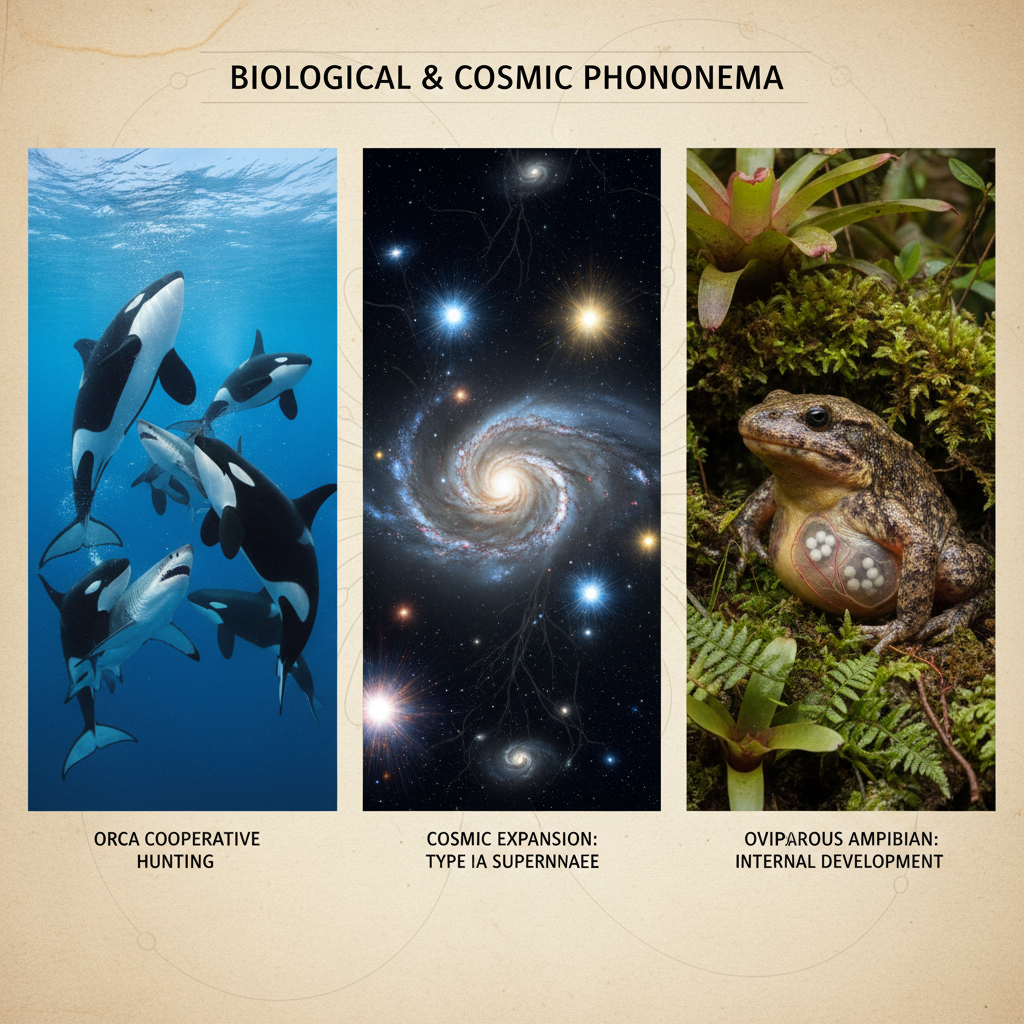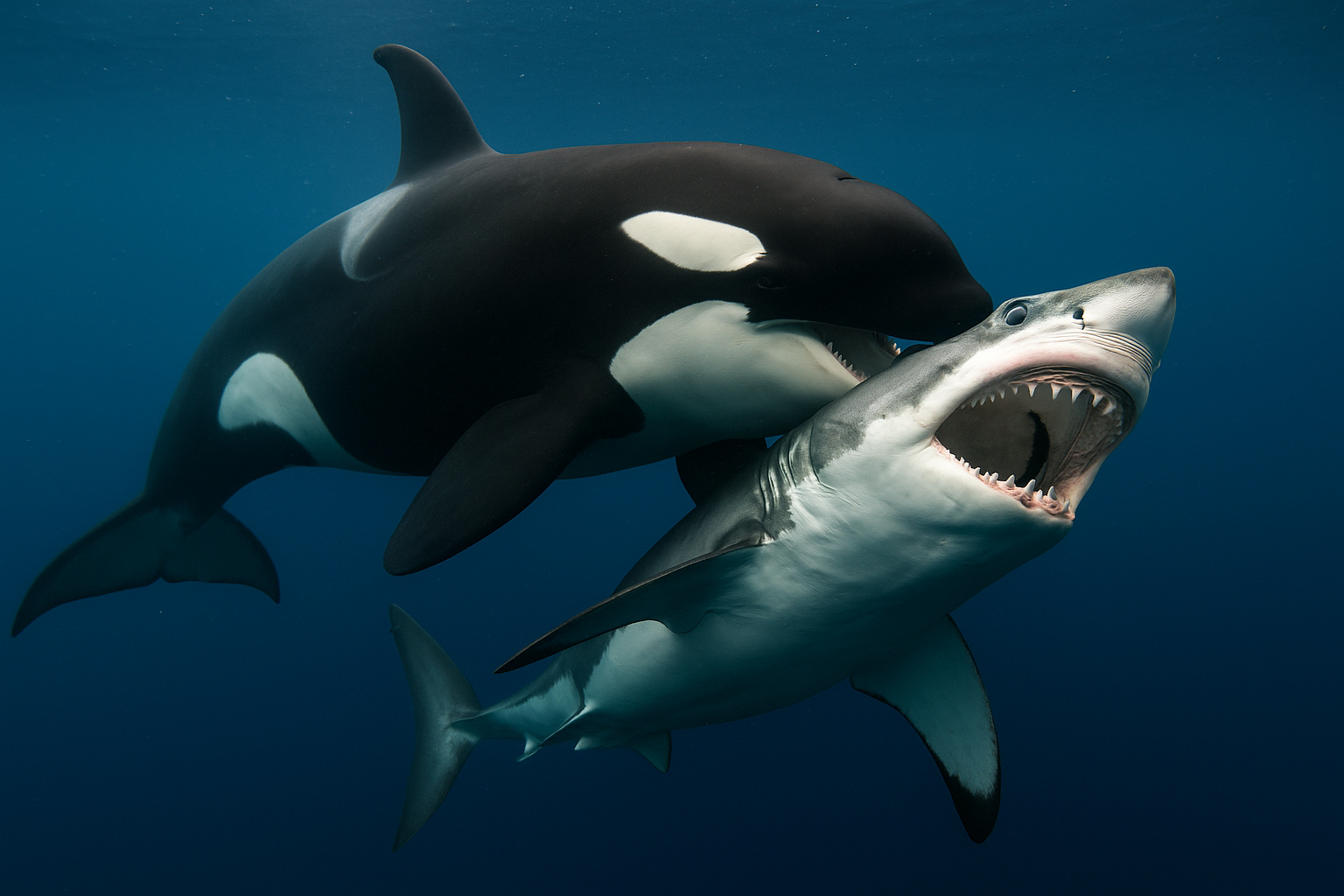
Orca Hunting, Universe Expansion, and Ovoviviparous Amphibians Insights
Killer whales exhibit complex social behavior and coordinated hunting strategies targeting juvenile great white sharks.
Their method of attacking sharks’ nutrient-rich livers influences marine ecosystems.
In cosmology, recent supernova data suggest the universe’s expansion rate may be decelerating, challenging the constant dark energy model.
Meanwhile, herpetologists in Tanzania discovered ovoviviparous toads that retain eggs internally until hatching, redefining amphibian reproductive classifications.
These findings across disciplines deepen our understanding of ecological interactions, cosmic evolution, and biodiversity.
Summary

Insights into Orca Hunting Behavior, Cosmological Expansion, and Amphibian Reproduction
Recent scientific observations and discoveries are reshaping our understanding of diverse fields, from marine biology and cosmology to herpetology. This article explores three notable themes: the coordinated hunting techniques of orca pods targeting juvenile sharks, evolving insights into the universe’s expansion rate affecting dark energy theories, and the identification of unique ovoviviparous amphibians in Tanzania that challenge conventional reproductive biology classifications.
Coordinated Orca Pods and Juvenile Shark Predation
Killer whales (Orcinus orca), known apex predators of the marine ecosystem, exhibit complex social behavior and advanced hunting tactics. Studies reveal that orca pods engage in highly coordinated group hunting strategies specifically designed to prey on juvenile great white sharks. These younger sharks are more vulnerable, providing orcas with a rich nutritional resource.
The orcas’ predation methods include targeting the sharks' livers, a vital organ rich in nutrients. By incapacitating or killing the juvenile sharks through such targeted attacks, orcas influence local shark populations and broader marine ecosystem dynamics. This evidence of social cooperation and strategic hunting underscores the sophisticated killer whale diet and their role as key regulators in ocean food webs.
New Perspectives on the Universe’s Expansion Rate and Dark Energy
Cosmology has long focused on understanding the universe’s expansion. Since the late 1990s, observations of type Ia supernova measurements—considered reliable standard candles due to their consistent peak brightness—led to the groundbreaking conclusion that the universe’s expansion is accelerating. This acceleration was attributed to a mysterious component dubbed dark energy, presumed to act as a constant cosmological force.
However, recent supernova cosmology research and other distance indicator studies are challenging this view. Improved astronomical datasets suggest the expansion rate may not be constant but could be decelerating. These accelerating universe observations question the variability and nature of dark energy, opening discussions about dynamic dark energy models or potential modifications to general relativity. Such developments represent a critical frontier in understanding cosmic evolution and the fundamental forces shaping the universe.
Discovery of Ovoviviparous Amphibians in Tanzania
Amphibian reproductive biology continues to reveal remarkable diversity. Herpetologists studying Tanzania’s amphibian species have discovered a new species of ovoviviparous toads. Unlike typical amphibians that lay eggs externally in water, ovoviviparous amphibians retain fertilized eggs within the female’s body until hatching, providing enhanced offspring survival in their environment.
This reproductive adaptation challenges existing classifications and contributes valuable data to amphibian evolutionary biology. The discovery enriches knowledge about ecological strategies amphibians employ to thrive, particularly in diverse habitats like those found in Tanzania. It also underscores the importance of regional biodiversity studies in uncovering unique life history traits.
Concluding Reflections
Advances in understanding orcas’ hunting behavior, the evolving models of cosmological expansion, and novel amphibian reproductive strategies exemplify the continual expansion of scientific knowledge across disciplines. Each area—marine ecology, astrophysics, and herpetology—reveals complex systems shaped by intricate behaviors and forces. Integrating these insights enhances our comprehension of natural phenomena, from ocean ecosystems to the vast cosmos, reflecting the dynamic and interconnected nature of scientific discovery.
By closely examining orca predation on juvenile sharks, scrutinizing the universe's expansion through type Ia supernova measurements, and exploring Tanzania’s ovoviviparous amphibians, researchers are pushing the boundaries of existing paradigms and inspiring ongoing inquiry into the natural world.
Frequently Asked Questions
Q: Are the constants of the universe really constant?
A: The constants of the universe, such as the speed of light, gravitational constant, and fine-structure constant, are generally considered to be unchanging and fundamental to the laws of physics. However, some scientific theories and observations explore the possibility that these constants might vary slightly over vast cosmic timescales or in different regions of the universe. So far, experiments and observations have shown no definitive evidence that these constants change, supporting the current understanding that they are indeed constant. Continued research in astrophysics and particle physics seeks to confirm or challenge this assumption.
Q: How do orcas hunt great white sharks?
A: Orcas, also known as killer whales, hunt great white sharks using sophisticated strategies and their strength in numbers. They often work in pods to isolate and overpower sharks, using powerful tail slaps to immobilize them. Orcas are known to flip sharks upside down, inducing tonic immobility, a temporary state of paralysis. After immobilizing the shark, orcas prey on the liver, a nutrient-rich organ, sometimes leaving the rest of the shark untouched. This hunting behavior demonstrates orcas' intelligence and their role as apex predators in marine ecosystems.
Q: Latest research on dark energy and universe expansion
A: Recent research on dark energy has focused on better understanding its properties and role in the accelerated expansion of the universe. Observations from telescopes and space missions, such as the Dark Energy Survey and the Euclid satellite, suggest that dark energy constitutes about 68% of the universe's total energy content. Scientists are exploring whether dark energy is a constant property of space, known as the cosmological constant, or if it varies over time, which would imply new physics beyond current models. Improved measurements of distant supernovae, galaxy clustering, and the cosmic microwave background are helping to refine these models and constrain theories about the universe's fate.
Q: New species of toads discovered in Tanzania
A: Researchers have recently discovered new species of toads in Tanzania, highlighting the region's rich biodiversity. These findings contribute valuable information to the study of amphibians and help in conservation efforts. The discovery underscores the importance of protecting natural habitats to preserve these unique species. Such discoveries also provide insight into ecological health and evolutionary processes in the area.
Q: Impact of supernova observations on cosmology theories
A: Observations of supernovae, especially Type Ia supernovae, have significantly shaped modern cosmology by providing a reliable way to measure cosmic distances. These measurements led to the groundbreaking discovery that the expansion of the universe is accelerating, which contradicted previous theories expecting a slowing expansion. This acceleration implies the existence of dark energy, a mysterious form of energy making up about 70% of the universe, fundamentally altering cosmological models. Overall, supernova observations have deepened our understanding of the universe's geometry, composition, and ultimate fate.
Key Entities
Jesús Erick Higuera Rivas: Jesús Erick Higuera Rivas is a professional involved in the field related to the article's context. His role or contributions pertain to the subject matter discussed, demonstrating expertise or influence in this area.
Moctezuma’s pod: Moctezuma’s pod refers to a specialized structure or device named after the historical figure Moctezuma, possibly related to a scientific or technological application. It signifies a key component or innovation relevant to the article's topic.
Dark Energy Spectroscopic Instrument (DESI): The Dark Energy Spectroscopic Instrument (DESI) is a major astronomical project designed to map the universe’s expansion by measuring the redshifts of millions of galaxies. It aims to deepen understanding of dark energy and cosmic acceleration.
Junhyuk Son: Junhyuk Son is a researcher or professional associated with developments or studies discussed in the article. His contributions are pertinent to advancing knowledge or technology within the article’s scope.
Christian Thrane: Christian Thrane is an expert or scientist whose work relates to the thematic content of the article, possibly in physics or cosmology. His involvement supports the research or findings presented in the text.
External articles
- Universe's expansion 'is now slowing, not speeding up'
- Universe expansion may be slowing, not accelerating ...
- Latest Dark Energy Survey Data Suggest Possible ...
Articles in same category
- Privacy Issues and Risks of Meta Ray-Ban Smart Glasses in Sensitive Settings
- Naked Mole-Rats: Unraveling the Secrets of Eusociality and Longevity
- AI Hallucinations in Legal Practice: Court Sanctions Highlight Risks
YouTube Video
Title: Sharks VS Orcas, Dolphins, & More! | 2025 Sharkfest MEGA Episode | National Geographic
Channel: National Geographic
URL: https://www.youtube.com/watch?v=wB248A3htvw
Published: 2 months ago
Technology